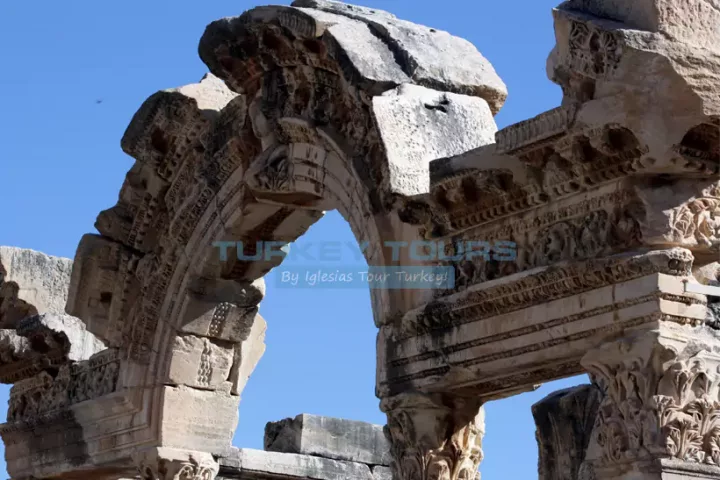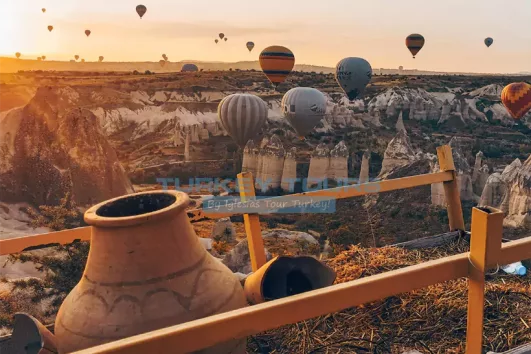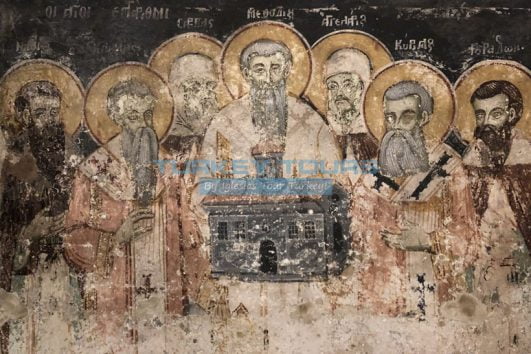APHRODISIAS TURKEY AND 5-HIGHLIGHTS OF APHRODISIAS ANCIENT CITY!
Hi everyone! We continue our blog series with a new one! In this post, we will focus on explaining Aphrodisias Ancient City and 5-Highlights of Aphrodisias Turkey which will help you during your potential visit to Aphrodisias!
THE DISCOVERY OF APHRODISIAS TURKEY
In 1958, the renowned photographer Ara Guler was tasked with the assignment of capturing the beauty of Kemer dam. However, when the driver lost his way, they stumbled upon the remarkable village of Geyre.
The walls of their homes were adorned with many architectural works and columns, while many sarcophagi were used to extract grapes and olive oil.
After documenting the beauty of the village and its artifacts, Ara Güler took his photographs to many places in Istanbul, yet they initially failed to receive much attention. As a last resort, he sent them to the New York Times, and the photographs he sent garnered great attention and admiration due to this newspaper.
It was later understood from the works of American archaeologists that there was a large, ancient Roman city dedicated to the goddess Aphrodite beneath the village of Geyre. Motivated by this discovery, Prof. Dr. Kenan Erim from New York University contacted Ara Güler and the two collaborated to explore the city of Aphrodisias further.
Subsequently, Kenan Erim began the excavations in 1961 and fell in love with the place. He spent the rest of his life in Aphrodisias, and upon his death on November 3, 1990, his tomb was constructed in front of the Tetrapylon (monumental gate) at Aphrodisias.
HISTORY OF APHRODISIAS ANCIENT CITY!
Today, one of the most important and richest archaeological sites in Turkey is Aphrodisias, in the southwest of Turkey lies on the edge of the Büyük Menderes River.
The city is named after Aphrodite, the goddess of love and beauty. Aphrodisias is one of the rare ancient cities where magnificent artifacts from the Hellenistic, Roman, and Byzantine periods have reached the present.
The history of the city is dated back to the 5th century BC. The approximate population is thought to be 20-25 thousand. The city, which was reconstructed with a grid plan in the 2nd century, attracted great attention with the temple built in the name of Aphrodite and reached the level of the City-State (Polis).
Being a City-State, it became one of the largest religious centers of the period. The biggest improvement was made in the 1st Century with the relationship that started with the Roman Empire. By the Roman Emperor Octavian “I chose this city for myself from all over Asia.” has gained more importance and great investments have been made.
Tax exemptions and some privileges were granted by the Roman Senate. For 200 years after Emperor Octavian, the city was further developed and enormous marble structures were built.
The city also had the most important sculpture school in the Mediterranean World. The sculptors who grew up here and their works became famous in many parts of the Roman Empire. It must be a great chance to be able to visit and photograph the extraordinary works of these sculptors in the museum of Aphrodisias and the ruins…
The greatest sign of wealth in Aphrodisias is the Temples, Odeon, Stadium, Theater, and magnificent sculptures built with quality marble obtained from the marble quarries in the north of the city. Aphrodisias had always been the city where sculpting was best explained and practiced in the Asian province of the Roman Empire.
Aphrodisias consists of many civil architectures such as baths, agora, odeon, theater, and stadium. Especially Aphrodisias stadium is one of the main buildings worth seeing. Being one of the most magnificent stadiums of antiquity, the building was home to approximately thirty thousand people.
With the division of the Roman Empire, the city passed into the hands of the Byzantine Empire. In the 4th century, the city became an important episcopal center. But it was not easy to destroy the Aphrodite cult in the city. That is why 2 important saints were martyred here.
In the 7th century, the city was called “stravpoli“, the city of the cross. The name “Aphrodisias” was especially erased from the city, which was dedicated to Aphrodite, a pagan goddess. The city started to be known as Kayra (Caria).
Earthquakes were the biggest problem in the ancient city of Aphrodisias like others; Ephesus, Miletus, Claros, Colophon located in the Aegean region in Modern Turkey.
The city, which is located on the fault line geologically, has suffered many earthquakes and received great damage. You can see examples of this in the buildings that were restored during your visit to Aphrodisias Ancient City.
The city collapsed due to political and religious conflicts coming from the east in the 7th century. In the 11-13 century, the region is taken under the rule of the Seljuk state. In the15-16 centuries, settlement started again due to the fertility of the region, and today’s GEYRE village was established.
5 MUST-VISIT HIGHLIGHTS OF APHRODISIAS
In the ancient city of Aphrodisias, there are dozens of buildings worth seeing and hours to spend! The must-see things we have listed for you are as follows;
APHRODISIAS TETRAPYLON
The remarkable tetrapylon of Aphrodisias is a monumental structure with four columned entrances, which took approximately 150 years to build by the extremely talented sculptors of the ancient city. This structure served as the gathering place for the ceremony procession before they moved on to the temple. It has recently undergone a restoration process, wherein 80% of the original pieces were used to recreate the structure’s original grandeur. It is truly a testament to the skill and craftsmanship of the Aphrodisias sculptors and a remarkable example of the ancient Latin language.
APHRODISIAS STADIUM
One of the most striking works in Aphrodisias is the magnificent stadium with 30 thousand people capacity. The structure, which is approximately 270 meters long and 50 meters wide, has given many spectators the opportunity to watch the shows perfectly due to its elliptical shape.
This stadium have a great importance because being one of the best well preserved ancient stadium not only in Turkey but also all around the world! Throughout history, it has been used for large public voting and festivals, as well as hosting many Greek games such as javelin throw, disc, athletics and so on.
Although the population of Aphrodisias was about 25 thousand, the higher capacity of the stadium shows us that many spectators were visiting Aphrodisias from outside the city to watch the shows and competitions. This is an important factor that contributes greatly to the economy of the city.
TEMPLE OF APHRODITE IN APHRODISIAS
The temple, which is one of the important buildings of the ancient city of Aphrodisias, was built in the archaic period. When the Assyrians came to Anatolia, they started to settle in fertile lands. They also brought their godesses Istar, goddesses of love and beauty.
Excavations in the temple have unearthed the descriptions of the king and queen of the period. Archeological works shows that they have been started the construction of the temple at 1st Century BC, and completed around 130 AD. During the reign of Emperor Hadrian, the temple was enlarged with sacred walls.
The temple has been one of the important pilgrimage centers in Anatolia for years. That’s why, it is believed that it was protecting those who took refuge in it.
The statue of Aphrodite, one of the most special pieces belonging to the temple, is exhibited in the Aphrodisias Museum. There are many different reliefs and symbols in the statue, which resembles the Ephesus Artemis. The temple of Aphrodisias was converted into a church and changes made in it around 5th century AD, with spreading of Christianity.
BOULETERION (ODEON) OF APHRODISIAS
The council/parliament building which was built around 2nd Century AD is the place where political issues are discussed. It had also been used in concerts and theaters for private guests of the emperors.
This building has a capacity of 1.700 people. The structure is covered with a roof, and the stage and orchestra parts are decorated with special mosaics. On the pedestal of the stage building, there were statues of important statesmen and wealthy people of that period.
It is possible to see the most beautiful sculptures of the Parliament building in the Aphrodisias Museum. The reason why there were such magnificent statues of statesmen in the parliament building is that they were wealthy people who were donated for all expenses of the parliament building.
Although it is known that the city was ruled by democracy, it was actually run by wealthy families who were closer to Rome. Rich people have seen statesmanship more as a profession. At that time, the best way to honor these people who cover the expenses of the Parliament building is to display their flamboyant sculptures in the building or in the city.
APHRODISIAS MUSEUM
Built on the walls of the Roman and Byzantine periods, the museum welcomes millions of history lovers every year. The museum, which includes the fascinating works of the best sculptors of Anatolia, is next to the ancient city of Aphrodisias.
It is possible to see artifacts from all periods in the museum, which consists of many sections. However, especially inlaid sarcophagi, magnificent sculptures, and enormous reliefs are indispensable for the museum.
FINAL THOUGHTS
Aphrodisias was one of the most important cities of its period. It is also one of the most important ancient ruins today. It may take hours to fully explore Aphrodisias. However, we strongly recommend you to visit this tranquil place, which is not preferred frequently by travelers, and discover the rich historical values left by the Byzantine and Pagan periods!
To create your best Turkey Tours schedule, continue reading our contents and benefiting them!
If you liked our posts, do not forget to share it with your friends!













